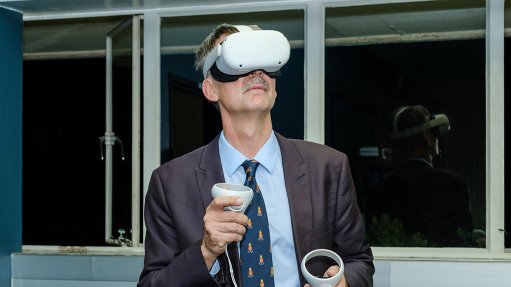Independent study confirms passive cooling benefits
State-owned energy research organisation the South African National Energy Development Institute (SANEDI) on April 22 said the results of an independent study of two sites in KwaZulu-Natal have confirmed the benefits of passive cooling, also called cool surfaces.
This has further motivated SANEDI to continue promoting cool surfaces as an energy-efficient alternative to mechanical heating, ventilation and air conditioning.
SANEDI approached its long-term partner organisation the German Development Agency in South Africa to procure the services of an expert consultant to document the results of two projects undertaken by stakeholders in the hot and humid KwaZulu-Natal province.
“Two sites were chosen, one industrial and one in the hospitality sector, to study the results of cool surface interventions in these applications. The assessment process included qualitative, or survey-based, and quantitative, or statistical, components. This enabled a holistic review and analysis of the technology applied, its measurable and perceived effects and acceptance among researchers, manufacturers and prospective users,” said SANEDI Energy Efficiency Cool Surfaces project officer Denise Lundall.
At the Saint Lucia Ecolodge, along the Saint Lucia Estuary, the study looked at the specific electricity requirements for one coated and one uncoated hotel bungalow. Isolated controlled experimental metering was used to determine the effect of the technology.
“Over the examined 24-hour period, a reduction of 1.3 kWh, or 5%, was observed. This means, over an average year in Saint Lucia, the lodge would gain a potential reduction of cooling energy consumption of about 600 kWh to 670 kWh, translating to a cost reduction of between R1 200 and R1 340,” explained Lundall.
The second study took place at KwaZulu-Natal-based paints manufacturer and supplier Genkem, which compared one coated and one uncoated repurposed container to determine the maximum temperature and the average temperatures over several days.
It was found that the mean average daily temperatures inside the containers differed by 1.9 °C and the mean maximum temperatures differed by 7 °C.
“This is a substantial difference and clearly demonstrates the significant potential for reducing electricity demand for cooling and improving thermal comfort during hot South African summers. This helped establish the impact of cool coating technology in reducing indoor temperature, energy consumption and demand,” Lundall said.
“While provisional studies and data from other countries showed us that cool surfaces were a good investment, we felt it was important to formally document the results of non-SANEDI initiated South African projects to further demonstrate the impacts of local cool surface interventions,” she pointed out.
SANEDI has been rolling out cool surfaces projects across the country in recent years, with the aim to provide a low-technology, energy-efficient cooling solution to communities. Partnerships and collaborations have enabled hundreds of thousands of square metres to be covered, by coating roofs and walls with a heat-reflective substrate designed to lower indoor air temperatures without the use of air conditioning.
SANEDI has also rolled out cool roofing projects in communities where local, unemployed people are trained as coating applicators to support the project and create jobs.
“There is local capacity and capability in South Africa, which can be leveraged to support the widespread application of cool coating in various sectors and building types,” concluded Lundall.
Comments
Press Office
Announcements
What's On
Subscribe to improve your user experience...
Option 1 (equivalent of R125 a month):
Receive a weekly copy of Creamer Media's Engineering News & Mining Weekly magazine
(print copy for those in South Africa and e-magazine for those outside of South Africa)
Receive daily email newsletters
Access to full search results
Access archive of magazine back copies
Access to Projects in Progress
Access to ONE Research Report of your choice in PDF format
Option 2 (equivalent of R375 a month):
All benefits from Option 1
PLUS
Access to Creamer Media's Research Channel Africa for ALL Research Reports, in PDF format, on various industrial and mining sectors
including Electricity; Water; Energy Transition; Hydrogen; Roads, Rail and Ports; Coal; Gold; Platinum; Battery Metals; etc.
Already a subscriber?
Forgotten your password?
Receive weekly copy of Creamer Media's Engineering News & Mining Weekly magazine (print copy for those in South Africa and e-magazine for those outside of South Africa)
➕
Recieve daily email newsletters
➕
Access to full search results
➕
Access archive of magazine back copies
➕
Access to Projects in Progress
➕
Access to ONE Research Report of your choice in PDF format
RESEARCH CHANNEL AFRICA
R4500 (equivalent of R375 a month)
SUBSCRIBEAll benefits from Option 1
➕
Access to Creamer Media's Research Channel Africa for ALL Research Reports on various industrial and mining sectors, in PDF format, including on:
Electricity
➕
Water
➕
Energy Transition
➕
Hydrogen
➕
Roads, Rail and Ports
➕
Coal
➕
Gold
➕
Platinum
➕
Battery Metals
➕
etc.
Receive all benefits from Option 1 or Option 2 delivered to numerous people at your company
➕
Multiple User names and Passwords for simultaneous log-ins
➕
Intranet integration access to all in your organisation


















